Vil gæld, ansvar og indfødte handlinger se solen gå ned på Ring of Fire?
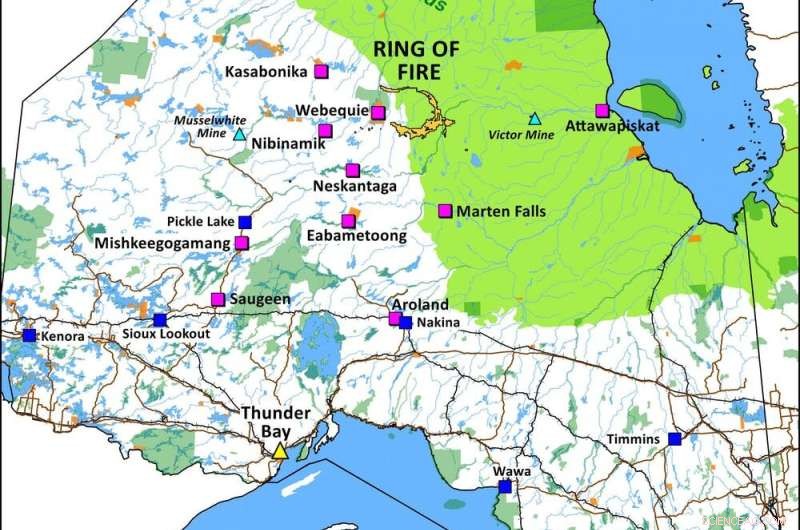
Et kort over Ring of Fire-regionen. Kredit:Noront Resources Ltd.
Noront Resources Ltd.-virksomheden i hjertet af Ontarios besværliggjorte Ring of Fire-mineudvikling - skaber igen overskrifter som genstand for konkurrerende virksomhedsovertagelsestilbud fra minegiganten BHP Billiton og det australske private investeringsselskab Wyloo Metals.
Budkrigen har fået Noronts aktiekurs til at hoppe 235 procent til det højeste niveau siden 2011.
Ud over aktiekurserne er den oprindelige opposition også steget, hvilket har rejst betydelige spørgsmål om levedygtigheden af de foreslåede minedrift og værdien af Noronts aktiver.
Neskantaga First Nation og Mushkegowuk Council, der repræsenterer syv berørte First Nations, bestrider åbenlyst omfanget og tempoet i mineudviklingen i deres territorier. De er i selskab med andre First Nations i hele regionen, som i årevis har hævdet deres politiske og territoriale autoritet over for Noronts foreslåede planer.
Påhævelse af jurisdiktion
Indfødte jurisdiktion og dens nægtelse af myndighederne har haft en enorm indflydelse på Noronts formuer. Udviklingen af virksomhedens flagskibsmine har været gået i stå siden 2011, og det samme har den 300 kilometer lange industrivej hele sæsonen – kaldet "vejen til ingensteds" på grund af dens tvivlsomme økonomiske udsigter – som er nødvendig for at få adgang til den fjerntliggende mineregion.
Dette skyldes, at regionens First Nations konsekvent har krævet, at Ontario anerkender deres jurisdiktion over deres lande og territorier. Matawa-nationerne, herunder Neskantaga, tvang oprindeligt provinsen til at forhandle en fælles regional tilgang til beslutningstagning.
Den såkaldte regionale rammeaftale stoppede provinsen fra ensidigt at sanktionere udvikling på oprindeligt land, men blev i sidste ende opløst af provinsen i 2019.
Indfødte myndigheder har siden fortsat hævdet deres jurisdiktion i regionen. Senest har en koalition af tre First Nations (Attawapiskat, Fort Albany og Neskantaga) insisteret på, at en nyligt etableret regional vurdering af de kumulative virkninger af foreslåede mine- og vejudviklinger ledes af indfødte.
I hele denne periode er Noront-aktierne faldet fra næsten 2 USD i starten af 2010 til mindre end 20 cent siden 2019. Virksomhedens gæld er steget med mindst 100 millioner USD siden 2013 til 299 millioner USD pr. 31. december 2020 og dets udestående lån stå på 51,4 millioner dollars.
På trods af stigende beviser for, at værdien af virksomheden og dens aktiver kræver indfødtes samtykke, er føderale og provinsregeringer fortsat med at hælde hundredvis af millioner af dollars i mineudvikling i Ring of Fire i form af efterforskningsfinansiering og infrastrukturstøtte.
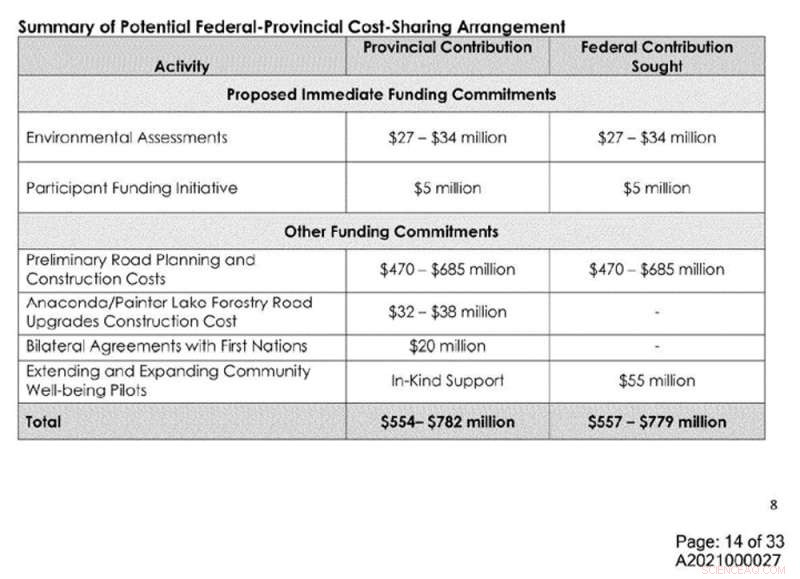
Et skærmbillede af interne dokumenter opnået via en anmodning om informationsfrihed viser omfanget af provinsielle og føderale investeringer i den foreslåede Ring of Fire-udvikling. (Forfatter angivet)
Millioner til udforskning
Efterhånden som godkendelsesprocesserne har trukket ud og derefter gået i stå, har Noront – støttet af føderale og provinsielle statskasser – forsøgt at skabe værdi ved at øge sine aktiver og udvide sit efterforskningsprogram.
Siden december 2008 viser virksomhedens lovmæssige ansøgninger, at de føderale og Ontario-regeringer har subsidieret Noronts Ring of Fire-udforskningsprogrammer med næsten 45 millioner dollars gennem en skattebaseret mekanisme kendt som flow-through-finansiering.
That mechanism allows firms to raise exploration funds from investors and return tax credits to them.
Additional federal and provincial refundable tax credits are also available to flow-through investors, resulting in the transfer of millions of dollars—money that would have otherwise been tax revenue—to Noront's exploration of the Ring of Fire. According to the company's aforementioned regulatory filings, Noront has raised more than $75 million of flow-through financing since 2008 for Ring of Fire properties.
This flow of government money reveals a system of economic relationships described by the Yellowhead Institute, a First Nations-led research center, as colonial and predatory.
Amid Indigenous demands to determine and control the pace of development in their territories and to create the institutions required to do so, this flow of money also raises serious concerns about the financial realities of the Ring of Fire project.
Circumventing Indigenous jurisdiction
While the province once estimated the cost of implementing the doomed framework agreement to be slightly over $20 million, the cost of circumventing Indigenous jurisdiction is much higher.
Since tearing up the agreement in 2019 in an attempt to speed up development, Ontario has entered into bilateral funding agreements worth $20 million with two First Nations currently serving as proponents of the all-season road.
According to documents obtained though an Access to Information request, it's also currently negotiating a planning agreement worth $38 million with another First Nation.
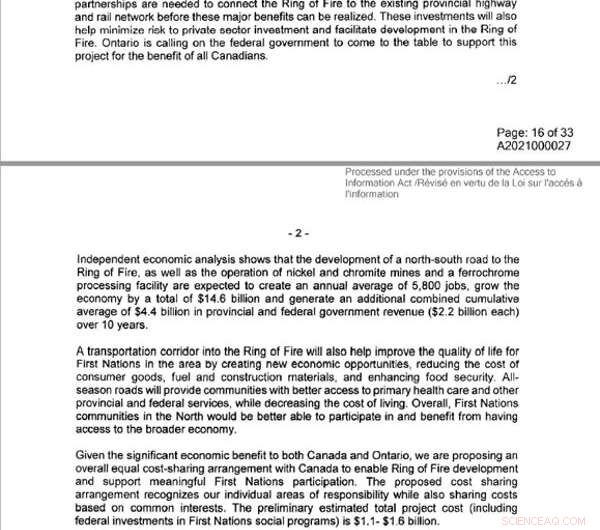
Internal documents obtained via a Freedom of Information request details Ontario’s proposal of a cost-share arrangement with Ottawa on the all-season road in the Ring of Fire. (Author provided), Author provided
These same documents reveal the federal government spent approximately $11 million annually since 2016 to fund so-called community well-being projects in five Matawa communities. These are programs purportedly aimed at improving "community readiness" for mining operations in the Ring of Fire.
If Ontario has its way, this funding will be renewed at a total of $55 million over five years. Between 2010 and 2015, Indigenous and Northern Affairs Canada contributed nearly $16 million through the strategic partnership initiative to "support First Nations mining readiness activities" in the area, an investment topped up by a few million in 2016.
It also contributed $255 million over two years to a First Nations fund partially earmarked to support regional infrastructure in the Ring of Fire and intended to encourage compliance with mining projects.
A 2019 intergovernmental memo—also obtained via the Freedom of Information request—shows the federal government also offered to "explore options to advance Ring of Fire projects" using money that was designated for well-being projects in Indigenous communities.
There's also the matter of the $1.6 billion all-season road. Ontario has promised to fund the road through the homelands of multiple First Nations, most recently through a proposed cost-share arrangement with Ottawa.
Debt, debt and more debt
Noront has consistently under-represented to investors, and now to corporate suitors, the legal and financial liabilities associated with Indigenous jurisdiction—and there are many.
Regardless of who successfully bids for the company, opposition to the Ring of Fire project is only likely to increase unless First Nations are empowered to exercise real control over the decisions that will impact them. This raises the specter of litigation, Indigenous land defense actions—and more debt.
According to the internal documents, the federal and provincial government are expecting to earn $4.4 billion in combined tax revenues during the first 10 years of the proposed mine's operation. But if they add up the amount of money they've already paid to defy and circumvent Indigenous jurisdiction, and the financial costs associated with continuing to do so, that $4.4 billion will soon be exhausted.
It is entirely likely that any profits related to this enterprise have already been spent. The question that remains is who will be left holding the debt?
 Varme artikler
Varme artikler
-
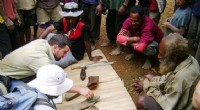 Grav efter artefakter bekræfter New Guineas neolitiske periodeDr. Ben Shaw og nogle lokalbefolkning fra New Guinea undersøger nogle få af de genstande, der er gravet frem ved udgravningsstedet i Waim i det nordlige højland. Kredit:UNSW/Ben Shaw Det er velken
Grav efter artefakter bekræfter New Guineas neolitiske periodeDr. Ben Shaw og nogle lokalbefolkning fra New Guinea undersøger nogle få af de genstande, der er gravet frem ved udgravningsstedet i Waim i det nordlige højland. Kredit:UNSW/Ben Shaw Det er velken -
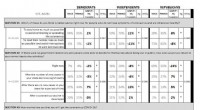 Kvinder er mere bekymrede over COVID-19 end mænd, undersøgelse finderCOVID-visninger efter køn og partiidentifikation (voksne i USA). (Tabel 2 fra undersøgelsen). Kredit:Bord leveret af Deborah Jordan Brooks og Lydia Saad. En undersøgelse fra Dartmouth-Gallup viser
Kvinder er mere bekymrede over COVID-19 end mænd, undersøgelse finderCOVID-visninger efter køn og partiidentifikation (voksne i USA). (Tabel 2 fra undersøgelsen). Kredit:Bord leveret af Deborah Jordan Brooks og Lydia Saad. En undersøgelse fra Dartmouth-Gallup viser -
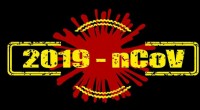 Hvordan coronavirus øger terrortrusler i udviklingslandeneKredit:CC0 Public Domain Da coronavirus når udviklingslande i Afrika og Asien, pandemien vil have konsekvenser ud over folkesundheden og økonomisk aktivitet. Mens sygdommen ødelægger i områder, de
Hvordan coronavirus øger terrortrusler i udviklingslandeneKredit:CC0 Public Domain Da coronavirus når udviklingslande i Afrika og Asien, pandemien vil have konsekvenser ud over folkesundheden og økonomisk aktivitet. Mens sygdommen ødelægger i områder, de -
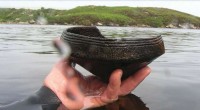 Nye beviser tyder på, at skotske crannogs tusinder af år ældre end antagetKredit: Antikken (2019). DOI:10.15184/aqy.2019.41 Et par arkæologer, en med University of Reading, den anden University of Southampton, har fundet beviser, der tyder på, at nogle crannogs i Skotl
Nye beviser tyder på, at skotske crannogs tusinder af år ældre end antagetKredit: Antikken (2019). DOI:10.15184/aqy.2019.41 Et par arkæologer, en med University of Reading, den anden University of Southampton, har fundet beviser, der tyder på, at nogle crannogs i Skotl
- Det bedste objektiv til at tage portrætter
- Forskelle og ligheder mellem enheder og celler
- Tidlige arter udviklede sig meget hurtigere end tidligere antaget, forskning viser
- Eksperter er forsigtige over Googles nanopartikelprojekt
- Kvarts vs Granit Countertop Vægt
- Hvor stammer kraftig luftforurening i Beijing fra?


